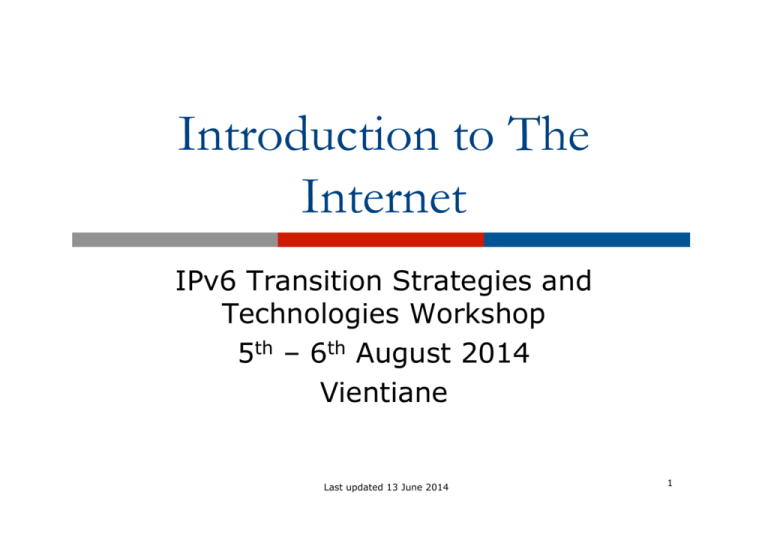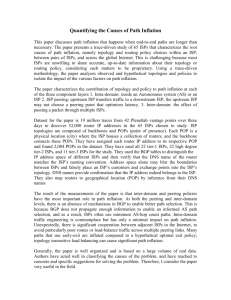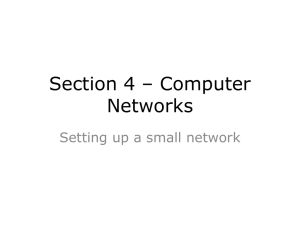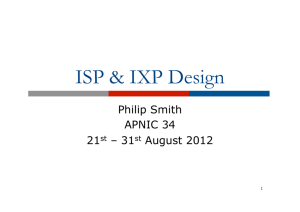Introduction to The Internet
advertisement

Introduction to The Internet IPv6 Transition Strategies and Technologies Workshop 5th – 6th August 2014 Vientiane Last updated 13 June 2014 1 Preamble p Course slides: http://www.itu.int/en/ITU-D/RegionalPresence/AsiaPacific/Pages/Events/2014/ August%20Laos/IPv6-Transition-Strategiesand-Technologies-Workshop.aspx n Please ask questions any time n This is an interactive workshop n 2 Introduction to the Internet p Topologies and Definitions p IP Addressing p Internet Hierarchy p Gluing it all together 3 Topologies and Definitions What does all the jargon mean? 4 Some Icons… Router (layer 3, IP datagram forwarding) Ethernet switch (layer 2, packet forwarding) Network Cloud 5 Routed Backbone p ISPs build networks covering regions n n p p p p Regions can cover a country, sub-continent, or even global Each region has points of presence built by the ISP Routers are the infrastructure Physical circuits run between routers Easy routing configuration, operation and troubleshooting The dominant topology used in the Internet today 6 MPLS Backbones p p Some ISPs & Telcos use Multi Protocol Label Switching (MPLS) MPLS is built on top of router infrastructure n n p Replaces old ATM technology Tunnelling over IP network Main purpose is to provide VPN services n Although these can be implemented with other tunnelling technologies such as GRE 7 Points of Presence p PoP – Point of Presence Physical location of ISP’s equipment n Sometimes called a “node” n p vPoP – virtual PoP To the end user, it looks like an ISP location n In reality a back hauled access point n Used mainly for consumer access networks n p Hub/SuperPoP n – large central PoP Links to many PoPs 8 PoP Topologies p Core routers n p Distribution routers n p connections to other providers Service routers n p high port density, connecting the end users to the network Border routers n p higher port density, aggregating network edge to the network core Access routers n p high speed trunk connections hosting and servers Some functions might be handled by a single router 9 Typical PoP Design Other ISPs Other ISPs Border Backbone link to another PoP Backbone link to another PoP Network Core Service Network Operation Centre Access Business Customer Aggregation Service ISP Services (DNS, Mail, News, FTP, WWW) Access Hosted Services Consumer Aggregation 10 More Definitions p Transit Carrying traffic across a network n Usually for a fee n p Peering Exchanging routing information and traffic n Usually for no fee n Sometimes called settlement free peering n p Default n Where to send traffic when there is no explicit match in the routing table 11 Peering and Transit example transit provider A peering IXP-West provider B provider E Backbone Provider C peering peering IXP-East Backbone Provider D provider F transit A and B peer for free, but need transit arrangements with C and D to get packets to/from E and F 12 Private Interconnect Autonomous System 334 Provider D border border Provider C Autonomous System 99 13 Public Interconnect p A location or facility where several ISPs are present and connect to each other over a common shared media p Why? n To save money, reduce latency, improve performance p IXP – Internet eXchange Point p NAP – Network Access Point 14 Public Interconnect p Centralised (in one facility) p Distributed (connected via WAN links) p Switched interconnect Ethernet (Layer 2) n Technologies such as SRP, FDDI, ATM, Frame Relay, SMDS and even routers have been used in the past n p Each provider establishes peering relationship with other providers at IXP n ISP border router peers with all other provider border routers 15 Public Interconnect ISP 1 ISP 2 ISP 3 ISP 4 IXP ISP 5 ISP 6 Each of these represents a border router in a different autonomous system 16 ISPs participating in Internet p Bringing all pieces together, ISPs: Build multiple PoPs in a distributed network n Build redundant backbones n Have redundant external connectivity n Obtain transit from upstream providers n Get free peering from local providers at IXPs n 17 Example ISP Backbone Design ISP Peer ISP Peer IXP ISP Peer ISP Peer Upstream1 Upstream 2 Upstream 2 PoP 2 Upstream1 PoP 1 Network Core Backbone Links PoP 3 PoP 4 18 IP Addressing Where to get address space and who from 19 IP Addressing Basics p Internet uses two types of addressing: IPv6 – the new IP protocol n IPv4 – legacy IP protocol n p Internet n uses classless routing Routers must be CIDR capable p Classless InterDomain Routing No routing assumptions made based on the address block n Engineers talk in terms of prefix length n For example: 158.43/16 and 2001:db8::/32 n 20 History of IP Addressing p Pre-CIDR (before 1994) n n n p The CIDR IPv4 years (1994 to 2010) n p Big networks got a class A Medium networks got a class B Small networks got a class C Sizes of IPv4 allocations/assignments made according to demonstrated need – CLASSLESS IPv6 adoption (from 2011) n n n Network Operators get at least one /32 End Sites get /48 IANA’s free pool is depleted (February 2011) – the size of IPv4 address allocations and assignments is now very limited 21 IP Addressing p IP Address space is a resource shared amongst all Internet users n n n n p Regional Internet Registries delegated allocation responsibility by the Internet Assigned Numbers Authority (IANA) AfriNIC, APNIC, ARIN, LACNIC & RIPE NCC are the five RIRs RIRs allocate address space to ISPs and Local Internet Registries ISPs/LIRs assign address space to end customers or other ISPs RIRs address distribution: n n IPv6 is plentiful IPv4 is very limited 22 Address delegation hierarchy IANA AfriNIC APNIC ARIN LACNIC (Africa) (Asia & Pacific) (N America) ISPs ISPs ISPs ISPs ISPs End Users End Users End Users End Users End Users (C&S America) RIPE NCC (EU,ME,C Asia) 23 Non-portable Address Space p “Provider Aggregatable” or “PA Space” Customer uses RIR member’s address space while connected to Internet n Customer has to renumber to change ISP n Aids control of size of Internet routing table n Need to fragment provider block when multihoming n p PA n space is allocated to the RIR member All assignments made by the RIR member to end sites are announced as an aggregate to the rest of the Internet 24 Portable Address Space p “Provider Independent” or “PI Space” Customer gets or has address space independent of ISP n Customer keeps addresses when changing ISP n Is very bad for size of Internet routing table n Is very bad for scalability of the routing system n → PI space is rarely distributed by the RIRs n 25 Internet Hierarchy The pecking order 26 Global Internet: High Level View Global Providers Regional Provider 1 Regional Provider 2 Content Provider 1 Content Provider 2 Access R4 1 Provider Access Provider 2 IXP Customer Networks 27 Detailed View of the Global Internet p Global Transit Providers n n p Regional Transit Providers n n n p Connect to each other Provide connectivity to Content Providers Provide connectivity to Access Providers Content Providers n n p Connect to each other Provide connectivity to Regional Transit Providers Cross-connect to Access Providers Peer at IXPs (free traffic to Access Providers) Access Providers n n Connect to each other across IXPs (free peering) Provide access to the end user 28 Categorising ISPs Tier 1 ISP $ $ $ $ $ $ $ $ Regional ISP $ $ $ $ Access ISP $ $ $ Tier 1 ISP Tier 1 ISP Tier 1 ISP Regional ISP Regional ISP Regional ISP IXP IXP Access ISP Access ISP Access ISP Access ISP Access ISP 29 Categorising ISPs p Tier-1 ISP – definition: n n A provider which peers with other Tier-1s and does NOT pay for transit Caveat: p p Regional providers often have the reach of Tier-1s but still have to rely on maybe one or two Tier-1s to access the whole Internet n p Many marketing departments call their ISP a Tier-1 – even though that ISP may still pay for transit to some parts of the Internet They often provide access too, via in country domestic access networks Access providers work exclusively in their locale 30 Inter-provider relationships p Peering between equivalent sizes of service providers (e.g. Regional to Regional) Shared cost private interconnection, equal traffic flows n No cost peering n p Peering n If convenient, of mutual benefit, technically feasible p Fee n across exchange points based peering Unequal traffic flows, “market position” 31 Default Free Zone The default free zone is made up of Internet routers which have explicit routing information about the rest of the Internet, and therefore do not need to use a default route NB: is not related to where an ISP is in the hierarchy 32 Gluing it together 33 Gluing it together p Who runs the Internet? n n p How does it keep working? n p No one (Definitely not ICANN, nor the RIRs, nor the US,…) Inter-provider business relationships and the need for customer reachability ensures that the Internet by and large functions for the common good Any facilities to help keep it working? n n Not really. But… Engineers keep working together! 34 Engineers keep talking to each other... p North America n n n p Latin America n n n p NANOG (North American Network Operators Group) NANOG meetings and mailing list www.nanog.org Foro de Redes NAPLA LACNOG – supported by LACNIC Middle East n n MENOG (Middle East Network Operators Group) www.menog.net 35 Engineers keep talking to each other... p Asia n APRICOT annual conference p n & Pacific www.apricot.net APOPS & APNIC-TALK mailing lists mailman.apnic.net/mailman/listinfo/apops p mailman.apnic.net/mailman/listinfo/apnic-talk p n PacNOG (Pacific NOG) p n mailman.apnic.net/mailman/listinfo/pacnog SANOG (South Asia NOG) p E-mail to sanog-request@sanog.org 36 Engineers keep talking to each other... p Europe n n p Africa n p p AfNOG meetings and mailing list Caribbean n p RIPE meetings, working groups and mailing lists e.g. Routing WG: www.ripe.net/mailman/listinfo/ routing-wg CaribNOG meetings and mailing list And many in-country ISP associations and NOGs IETF meetings and mailing lists n www.ietf.org 37 Summary p Topologies and Definitions p IP Addressing n PA versus PI address space p Internet Hierarchy Local, Regional, Global Transit Providers n IXPs n p Gluing n it all together Engineers cooperate, common business interests 38 Introduction to The Internet IPv6 Transition Strategies and Technologies Workshop 5th – 6th August 2014 Vientiane 39




